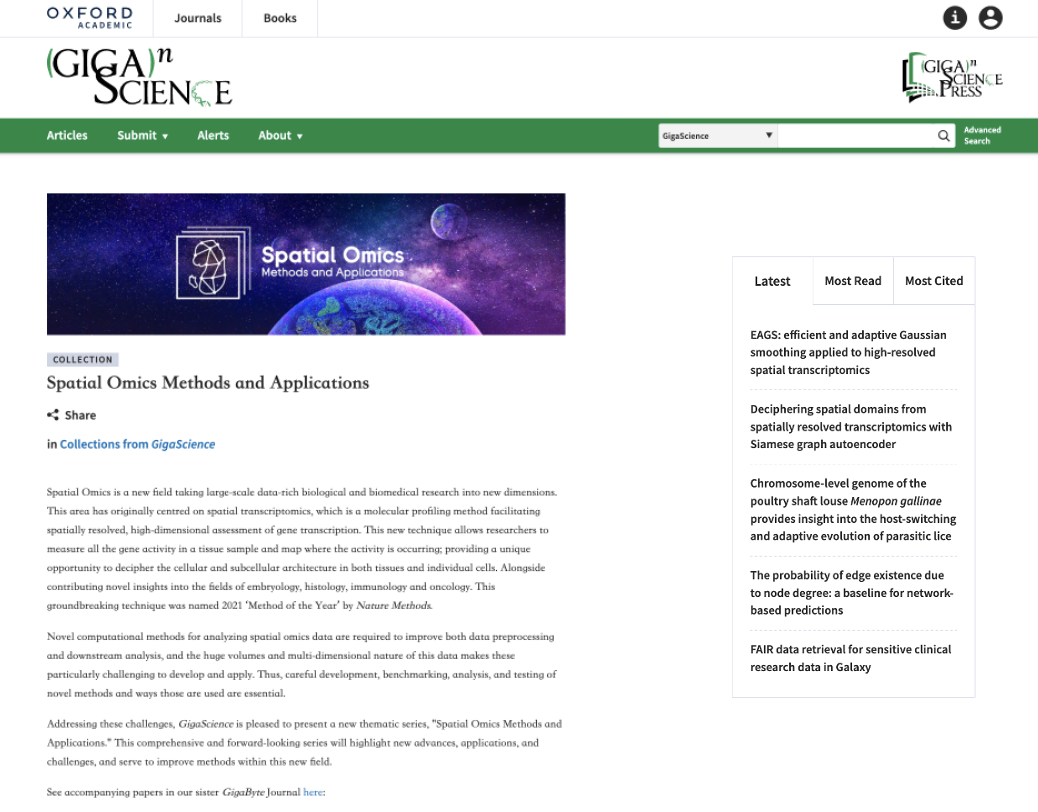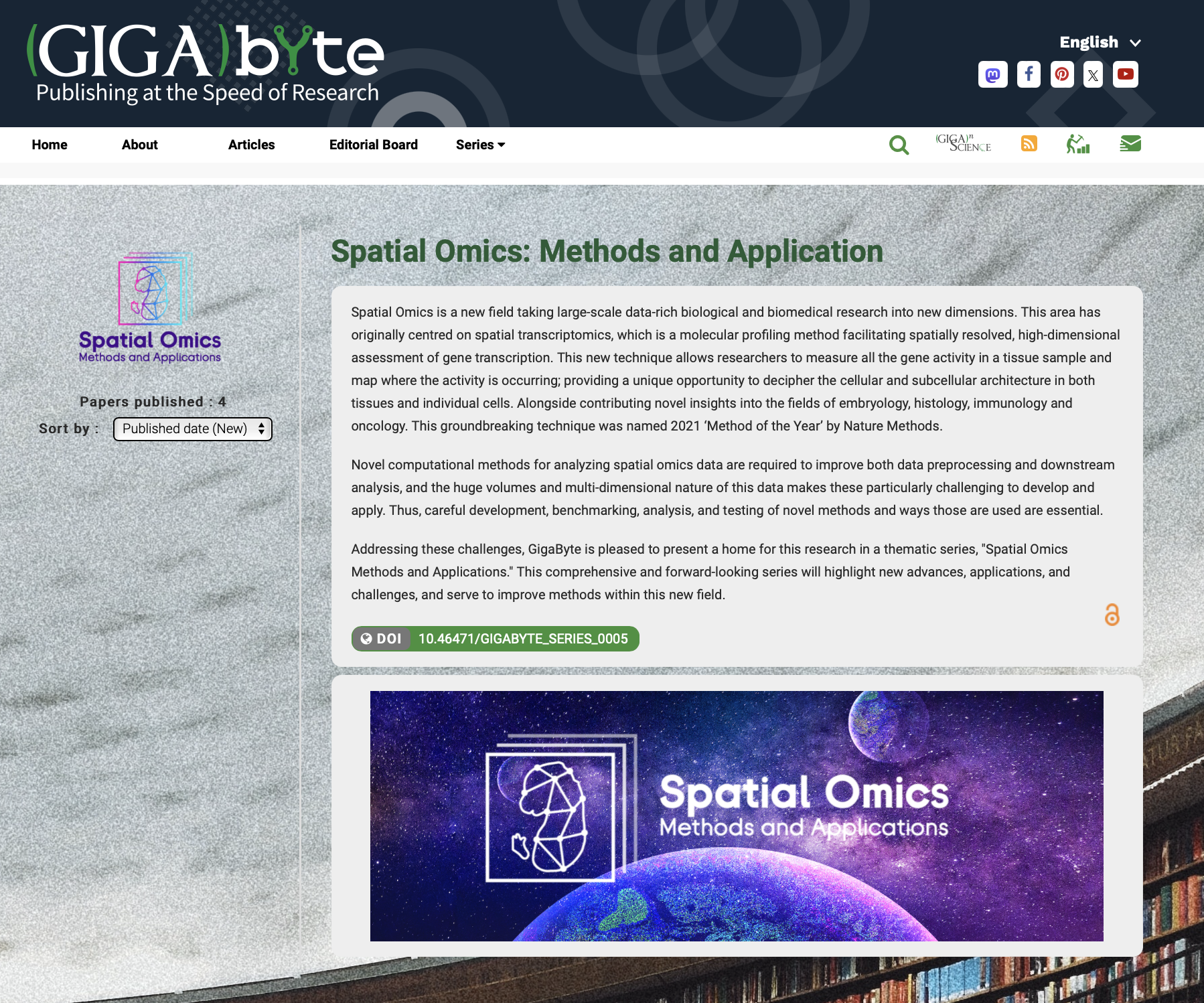On February 20, BGI-Research introduced a new suite of algorithmic tools designed to enhance the analysis of spatial transcriptomics (ST) data, providing more refined and reliable analytical outcomes for researchers exploring the complex world of spatial transcriptomics. The first batch of six tools, which represent a significant enhancement in processing intricate ST data, were introduced in GigaScience and GigaByte.

 BGI-Research introduces a new suite of spatial transcriptomics algorithmic tools in GigaScience and GigaByte.
BGI-Research introduces a new suite of spatial transcriptomics algorithmic tools in GigaScience and GigaByte.
ST is an innovative, high-throughput analysis method that combines RNA sequencing with spatial information from tissue, pinpointing the transcriptomes and their locations within tissues or cells. While single-cell transcriptomics can provide an overall transcriptional profile, it lacks the ability to identify spatial distribution among cell types within tissues.
The advent of ST has bridged this gap, revealing patterns of spatial distribution, interactions between cellular subgroups, and the positioning of cell types within various tissue structures. This is pivotal for understanding cellular functions and interactions, as well as revealing developmental processes, pathological changes, and mechanisms of disease progression.
The ST sequencing process encompasses steps of sample preparation, RNA capture, RNA sequencing, image acquisition, data registration, and data analysis. Researchers often face challenges in data handling and preprocessing, dataset integration and normalization, and data clustering and functional annotation. Traditional algorithmic tools primarily focus on gene expression levels while overlooking spatial information, complexity, or cell-to-cell interactions.
The new suite of algorithmic tools developed by BGI-Research employs advanced statistical techniques and algorithms to efficiently handle and preprocess ST data, addressing the issues that conventional methods could not resolve. They can create, at a single-cell level, spatial gene expression atlases that provide researchers with more precise and detailed information on cell types and spatial positioning. The tools also accurately remove noise and batch effects from these atlases, enhancing data quality and reliability. Moreover, the tools offer innovative analysis methods to explore cell type interactions and gene expression patterns.
BGI-Research's development team has validated the broad applicability of these tools across multiple ST sequencing platforms. The tools have shown exemplary performance on data generated from BGI Group’s Stereo-seq platform, which features a large field of view and ultra-high precision, capable of detecting over 25,000 genes simultaneously. They are also compatible with other platforms that are commonly used.
The tools have been made open-source on GitHub for free download and use, reflecting BGI’s commitment to supporting the wider research community. The popularity and support for these tools are evident, with the Stereo-Seq Analysis Workflow (SAW) algorithm being “starred” (bookmarked) nearly 100 times on GitHub, and the Efficient and Adaptive Gaussian Smoothing (EAGS) and BatchEval Pipeline tools being downloaded nearly 2,500 times in total.
Dr. Wang Qianwen of the Department of Bioinformatics at the School of Basic Medical Sciences, Southern Medical University, has welcomed the release of the tools. "We are currently applying SAW to our project analyzing spatiotemporal transcriptome sequencing data in brain science. The SAW tool is user-friendly in terms of deployment and learning curve, supported by clear instructions, and it offers rapid performance. Additionally, the software features fast response times for updates and debugging.”
“The release of these algorithmic tools marks a pivotal step forward in spatial transcriptomics, promising to drive the research and application of this innovative field to new heights,” said Dr. Xu Xun, Director of BGI-Research. “Through these advancements, BGI-Research reaffirms its position at the forefront of life sciences research, providing the tools necessary for researchers globally to gain deeper insights into the complexities of biological systems.”
For the next step, the BGI-Research team aims to improve the functionality, efficiency, and accuracy of the existing tools. They are also exploring the application of new technologies and methods to enhance tool performance and expand their application scope. The team is eager to forge and expand collaborative efforts to utilize these algorithms in tackling the challenges encountered in biological research.
For more information, please visit the features published in GigaScience and GigaByte:
GigaScience: https://academic.oup.com/gigascience/pages/spatial-omics-methods-and-applications
GigaByte: https://doi.org/10.46471/GIGABYTE_SERIES_0005
The research papers can be accessed here:
1. Cao L et al. Deciphering spatial domains from spatially resolved transcriptomics with Siamese Graph Autoencoder. GigaScience 2024 doi:10.1093/gigascience/giae003
2. Gong C et al. SAW: An efficient and accurate data analysis workflow for Stereo-seq spatial transcriptomics. GigaByte 2024 doi:10.46471/gigabyte111
3. Zhang C. et al. BatchEval Pipeline: Batch Effects Evaluation Workflow for Multi-batch Dataset Joint Analysis. GigaByte 2024 doi:10.46471/gigabyte108
4. Lv T et al. EAGS: efficient and adaptive Gaussian smoothing applied to high-resolved spatial transcriptomics. GigaScience 2024. doi:10.1093/gigascience/giad097
5. Ivanovic M et al. A Novel Variable Neighborhood Search Approach for Cell Clustering for Spatial Transcriptomics. GigaByte 2024 doi:10.46471/gigabyte109
6. Kang Q et al. Generating single-cell gene expression profiles for high-resolution spatial transcriptomics based on cell boundary images. GigaByte 2024 doi:10.46471/gigabyte110
The tools can be accessed here in GitHub:
EAGS: https://github.com/STOmics/EAGS
SGAE: https://github.com/STOmics/SGAE
SAW: https://github.com/STOmics/SAW
STCellbin: https://github.com/STOmics/STCellbin
BatchEval: https://github.com/STOmics/BatchEval
VNS: https://github.com/STOmics/VNS



